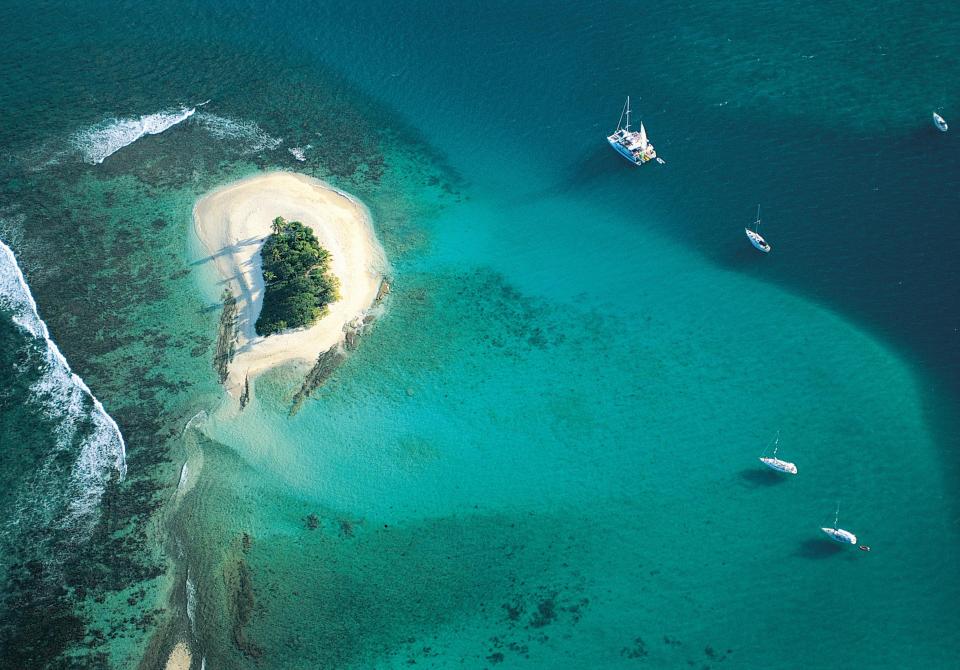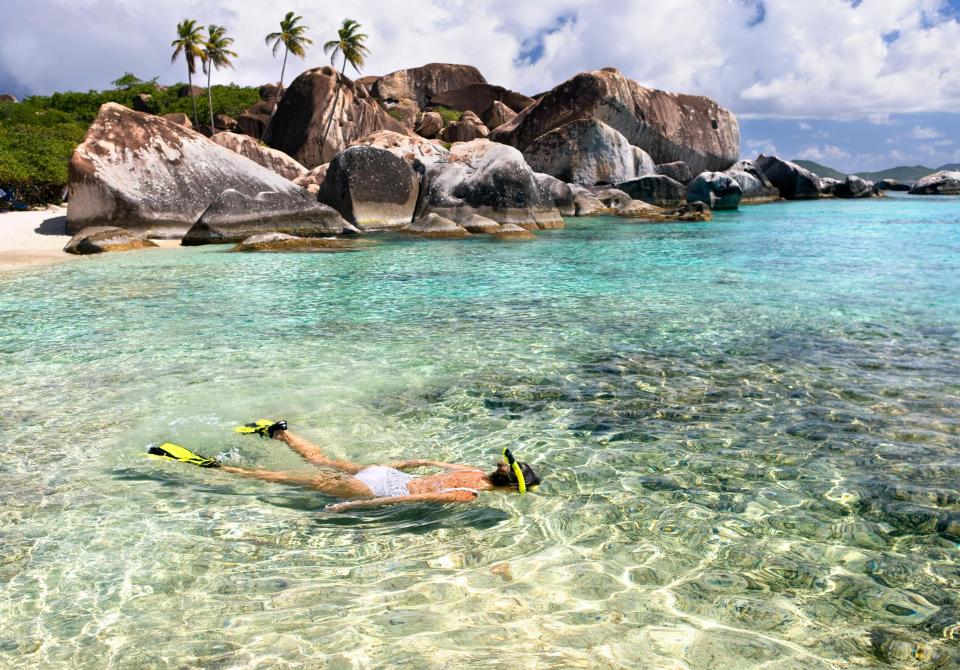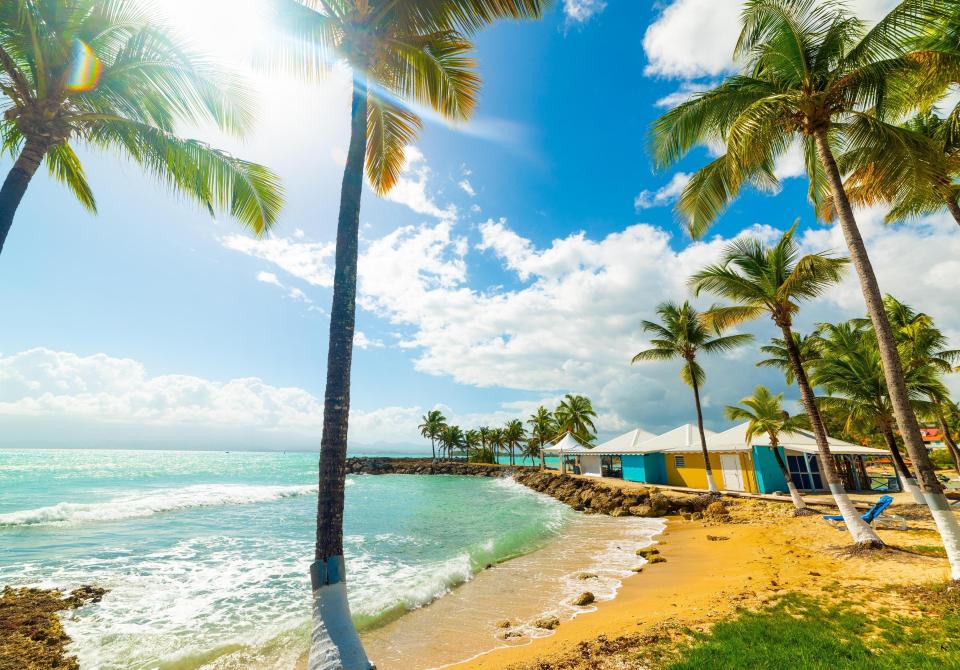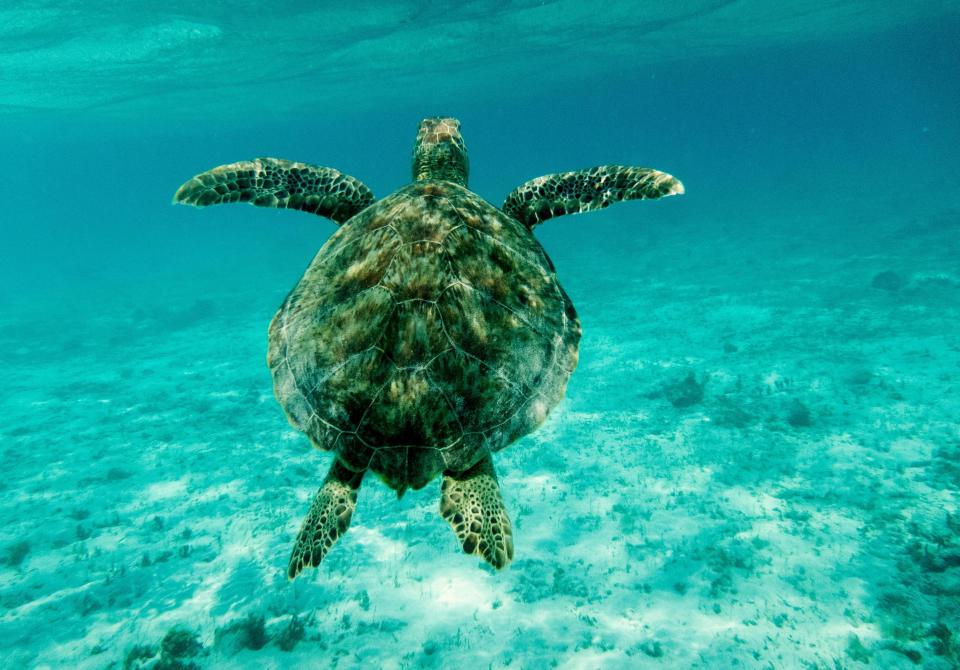The Caribbean is far more than an island playground. It’s a series of playgrounds, each with its own character. Some sailors spend a week at a time exploring here and there, while others spend entire lifetimes getting to know them all.
Capt. Frank Ficken of the Oyster 65 Latitude isn’t quite at lifetime status yet, but after 25 years of cruising from the Virgin Islands in the northern Caribbean to the Grenadines down south, he has learned a thing or two about the best destinations and experiences.
Here are Ficken’s suggestions for how sailors can enjoy the best of the Caribbean.
SAIL THE DREAM – GET THE INSIDE TRACK FROM ONE OF OUR CHARTER SKIPPERS' LIFETIME OF CARIBBEAN ADVENTURES AS HE SHARES THE MUST-VISIT LOCATIONS, THE GO-TO ISLANDS AND RECOMMENDATIONS FOR THE BEST PLACES TO EAT, DRINK AND SOAK UP THE CARIBBEAN CULTURE.
There are three parts of the Virgin Islands: the U.S. Virgins, the British Virgins and the Spanish Virgins. The British Virgins tend to be the busiest, especially for charter boats, followed by the U.S. Virgins and the quieter Spanish Virgins.
“The general concept of the Virgin Islands is that God wanted to sit down and create a place where people could sail and have a great, protected harbour available to them no matter which direction the wind and waves are coming from,” Ficken says. “On any given day, you can decide whether you want to anchor in a hot spot and go to the beach and drink, or cruise five miles to another harbour where you’re one of maybe three boats in a quiet cove. That’s what makes the Virgin Islands special.”
One of the best things about sailing in the British Virgin Islands is that the islands are close together, making for easier navigation than in destinations where the geography is more spread apart. There are numerous ports of entry and exit for these islands, including Road Harbour and West End Harbour on Tortola; Gun Creek in North Sound on Virgin Gorda; Great Harbour on Jost Van Dyke; and Thomas Bay on Virgin Gorda.
Many sailors start at Road Town, which offers the largest natural harbour on the island of Tortola, as well as numerous marinas with transient slips, knowledgeable mechanics and provisioning. There also are some anchorages in this area with mooring fields. Getting there includes sailing up the Sir Francis Drake Passage to the buoys that mark the harbour entrance. Watch for the flashing green buoy that marks a reef on the east side, as well as for the flashing red buoy that warns sailors about Scotch Bank.
For sailors who want to enjoy the throbbing heart of the BVI, Ficken recommends Jost Van Dyke in the British Virgins. It’s home to the Soggy Dollar Bar at White Bay (sailors often swim here, hence the soggy dollars) and Foxy’s at Great Harbour.
“Those are two of the most epic beach bars in the world,” Ficken says. “They’re must-see spots for nightlife, and that includes nightlife during the afternoons.”
Virgin Gorda offers a quieter scene. There, the Bitter End Yacht Club recently reopened, with restaurants, bars, provisioning and water sports, after several years of rebuilding following the devastation of Hurricane Irma. This yacht club is a storied destination for sailors, who have been cruising to the location since 1969. It’s a family-friendly atmosphere that takes its name from the fact that it is “the end of the line” before the Caribbean Sea meets the open Atlantic Ocean.
For an even more subdued cruising ground in the BVI, there is Peter Island, near Norman Island in the British Virgins. The approach into Great Harbour is straightforward, and the southeastern corner offers the best protection from storms. There also is a mooring field to the southwest; it can be a bit choppier, but it offers lovely views of the sunrise.
“Peter Island is more upscale, there’s a very nice resort there, the Peter Island Resort & Spa. There’s a restaurant and a beach bar, but you go there to have a cocktail and enjoy a peaceful, quiet beach.”
In the U.S. Virgin Islands, Ficken is a fan of St. John. While many sailors provision and start an itinerary at the commercial hub of St. Thomas, the island of St. John is far less touristy. Caneel Bay on St. John is usually the sailor’s first stop and there are free mooring balls for transient boats. Some sailors recommend avoiding Cruz Bay as an anchorage because of ferry traffic, but they do take dinghies over to Cruz Bay for a look around town, which has colourful shops full of local arts and crafts.
“It’s a funky, laid-back vibe. Caneel Bay’s restaurant, ZoZo’s, do a fixed-price dinner that gets rave reviews.”
On any given day, you can decide whether you want to anchor in a hot spot and go to the beach and drink, or cruise five miles to another harbour where you’re one of maybe three boats in a quiet cove.
As with the Virgin Islands, the Caribbean’s Leeward Islands each have something different to offer. St. Martin, for instance, is a hub of marinas, services and provisioning. Boats of all shapes and sizes tie up here before or after a Caribbean cruising itinerary.
“That’s a great place to get your boat worked on, to get any service you need. There’s shopping like you would find in America or Europe. You can provision anything you need for the boat or for yourselves. And, they have the international airport.”
St. Martin is actually two islands in one. The French section, known as St. Martin, is to the north while the Dutch section, called St. Maarten, is to the south. While they share an island, the two sections have their own cultures. Marigot is the capital in the French section and is where sailors can clear in. For arrivals in the Dutch section, clearance is at Great Bay or Simpson Bay, with access to the main town of Philipsburg and its commercial centre and shopping.
Once the boat is provisioned, serviced and ready to leave this island, Ficken often sets course for St. Barths. It’s a great destination year-round—the restaurants are world-class and the shopping can compete with Rodeo Drive in Beverly Hills. The main port, Gustavia Harbour, has a first-come, first-served dock for tying up, as well as room in the harbour for about 40 yachts to anchor (depending on how big they are, since sailors and superyachts are often anchoring side-by-side).
The island of St. Barths is especially popular on New Year’s Eve. “New Year’s Eve in Gustavia Harbor is an event not to be missed.
Every major yacht in the world is there. It’s a couple of billion dollars’ worth of boats in one place in the Caribbean and it stretches all along the south coast of the island. It’s the most impressive gathering of yachts that most people will ever see.”
The laid-back counterpoint to that scene is the island of Anguilla, which minimises the number of yachts allowed. Visitors can sink their toes into the pink-sand beaches or spend a night or two ashore in a private villa at Rendezvous Bay. It’s straightforward to sail into this bay but note the location of Shaddock Point on the charts. That’s a shoal to avoid.
“If you want to go, you have to contact one of a handful of agents who process yachts in and out of Anguilla. They charge a fee to do that, but it limits the number of yachts, so you never get overcrowded.”
Not far from there is the island of Antigua and the historic Nelson’s Dockyard at English Harbour where Admiral Horatio Nelson lived in the 1780s.
Nelson’s Dockyard is another spot where cruising sailors can often find themselves docked shoulder-to-shoulder with mega yachts. There are 30 stern-to berths, along with modern services such as shore power, internet and cable TV hookups.
“It is the most historic harbour in the Caribbean. It’s the Caribbean home of Oyster. When someone pulls in aboard an Oyster in Antigua, the people in Nelson’s Dockyard treat them extra special,” says Ficken.
Antigua is also home to the annual Antigua Classic Yacht Regatta, which includes some of the best-known older yachts afloat.
“It’s a phenomenal opportunity for Oyster owners or charter guests to go out with these yachts. One of the races goes out straight toward Guadeloupe and comes back. On either side of that course, there’s a spectator fleet lined up. You see these massive, old, spectacular sailing yachts that were once owned by historical figures.”
Compared with the Leeward archipelago, the Windwards have far less of what Ficken calls “yachting pressure.” There just aren’t as many boats in the Windwards, so cruising is a quieter, calmer experience.
“The Virgin Islands, St. Martin, Anguilla and even into Antigua—that’s a world where anyone coming from Europe or the United States will be very familiar with what they find,” he says. “When you head to the Windward Islands, you’re going to find something different. Geographically, the islands are huge. Many of them have rainforests. They have a lot less tourism, so when you go ashore, it’s more remote and less developed. You will find real people in real towns. It’s authentic.”
Guadeloupe is one of his favourite islands in the whole of the Caribbean. Specifically, he likes to visit a small island group near there called Les Saintes. Its bay is a horseshoe shape with a sheltered anchorage and about 80 mooring balls.
“It’s the coolest thing,” he says. “Terre-de-Haute is the name of one of the islands, and there’s a small, French village there. If you dinghy in from your boat, you can sit in a small French café. The vibe, sitting there, makes you feel like you’re in a town outside of Paris, but you’re in the Caribbean. There are old French forts that you can hike to. The snorkelling and scuba diving are phenomenal.”
Even more great scuba diving awaits about halfway down the west coast of Guadaloupe, in the Pigeon Islands—where there are a fair number of dive boats, especially during the prime months of December through to May, so sailors need to keep an eye out for scuba flags and people in the water. These islands are a reserve? sometimes called “Réserve Cousteau,” after the famed explorer Jacques Cousteau.
“He proclaimed that it was his favourite place to scuba dive in the world, and it really is phenomenal. It has, in a relatively small area, a wide variety of diving environments. There’s wall diving and there is an area that is very flat with coral that’s great for snorkelling, with a great variety of fish. It has some of the best coral and fish that you will find in the Caribbean.”
Another great island for getting back to nature is Dominica. Most sailors arrive at Roseau, on the island’s southern end, where boats can drop anchor or tie up to a mooring buoy. Another option up at the north end is Portsmouth. Outside of those two main anchorages, anchoring can be difficult on this island because of the steep drop-offs underwater.
But there is much beauty to be seen ashore after the boat is settled in. Part of the island is a UNESCO World Heritage Site and there is a rainforest that is unspoiled for hiking. Sailors who visit Dominica can do river-adventure tours that include rappelling down waterfalls.
“That was one of the best days we’ve had,” Ficken says. “It’s one of the most natural islands.”
St. Lucia, too, has pristine areas. It’s best known for the Pitons—twin volcanic spires that climb more than 2,000 feet skyward. Pitons Bay is the place where most sailors tie up, close to the town of Soufriere. The bay is smack in the middle of the two pitons, so wind gusts can be substantial and there is sometimes a strong current.
Even still, it’s worth watching the weather and cruising in when you have the chance.
“We have spent many happy afternoons and evenings anchored right underneath the Pitons,” he explains. “It’s hard to convey how impressive the Pitons are when you’re on a mooring and you’re 50 or 100 feet off the shore, and they just shoot straight up to the sky. They dominate you. You sit there and watch the sunset.”
Terre-de-Haute is the name of one of the islands, and there’s a small, French village there. If you dinghy in from your boat, you can sit in a small French café. The vibe, sitting there, makes you feel like you’re in a town outside of Paris, but you’re in the Caribbean.
Find out more
A whole other type of experience can be had at Mustique, an island that everyone should visit because its manicured atmosphere is so different. It's also important to pay attention to the weather here and time your arrival, as big swells can be uncomfortable in the anchorage. But in calm conditions, the location is a stunner, and at the right times of the year, it’s an island that is ideal for people-watching.
“It’s home to Basil’s Bar, one of the most famous bars in the world. Anytime you stop in, there’s a reasonable chance that some celebrity or political figure will be sitting there. The island is popular with that crowd because the island doesn’t get as many tourists.”
At the end of January and into early February, sailors can take in the Mustique Blues Festival.
“They start before the sun sets, so you’re sitting there in Basil’s overlooking the Caribbean sunset, listening to the world’s most famous blues musicians.” “If you happen to be staring out at the water and look to your right, that is the beach where all the fishermen drag their boats up. These are colourfully painted wooden skiffs. You are 75 or 100 feet from them. It is one of the most stunningly beautiful scenes in the Caribbean.”
Farther to the south, Ficken recommends a visit to the Tobago Cays. Many sailors use the approach that has day markers between Mayreau and Baleine Rocks. Be sure to keep the boat between the markers here; sizable coral heads lurk beneath the water’s surface. Also, look for mooring balls. In some parts of these islands, the currents can be strong, so a mooring ball is an easier bet than anchoring out.
All around in the Tobago Cays, wildlife dominates—both above and below the waterline. Sea turtles, colourful fish and coral are all around. There are also local boats that will come calling, offering to sell visiting sailors ice, lobsters, crafts and more. Some of them can help sailors arrange beach barbecues for the whole family.
A lesser-known spot in that same area is Chatham Bay on the west side of Union Island. It’s a quiet anchorage that usually has limited swell. And it’s a location that people will only see if they arrive by boat.
“It has a couple of wonderful beach bars that serve phenomenal, locally cooked food. They’re not at all fancy, but they’re the kind of place that you buy a yacht for,” he says. “Even in the Caribbean, where there’s a lot of sailboats and people visiting, Chatham Bay hasn’t been discovered much yet.”
Discovering all that the Caribbean offers can take sailors a lifetime, and Frank Ficken is on his way! It can also be done during a week of cruising now and then, or during entire seasons spent living on board. No matter how sailors choose to explore this region, memories of all kinds are waiting to be made. That’s the beauty of these islands: Each one offers something just a bit different and special.



